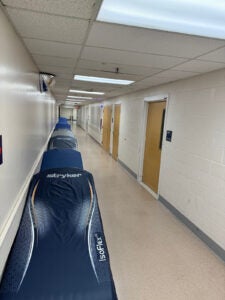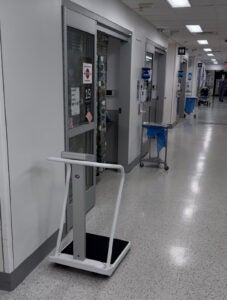

Rudy Beverly, Manager of Transportation Distribution Services and Fire Safety Workgroup member (Photo by Cece Rooney)
Safety and Security: Corridor Clutter
The accumulation of clutter — laundry bins, scales, IV poles, boxes, chairs and more — lining corridors throughout our hospital isn’t just an eyesore or a feng shui no-no. It’s a safety hazard. According to Jeff Smith, Senior Manager of Compliance and co-chair of the Fire Safety Workgroup, it’s time for us to do something about our littered hallways.
“Corridor clutter is equally as important as any other patient safety risk,” he says. “But it is the most prominently ignored risk.”
“It’s not just what’s in the patient’s room. What’s sitting outside is just as important,” adds Rudy Beverly, Manager of Transportation Distribution Services and Fire Safety Workgroup member. “Patients are transported through the hospital 24/7 and they need a safe passageway.”
While it’s easy for most of us to turn a blind eye to the ebb and flow of misplaced stuff we hurry past each day, Smith and Beverly are striving to shine a light on the issue to avoid injuries and remain in compliance with fire regulations.
Calling On Clinical Leaders
Smith has worked to tackle this problem at other hospitals, and says he’s seen some progress here since he arrived at UVA Health three years ago. However, to make lasting change, Smith says it’s going to require a culture shift.
“Although the regulations are in the Life Safety category, I’ve found clinical leaders are the most impactful at making improvements,” he says. “If they emphasize to their team the dangers of leaving things in the wrong location, we’ll see some traction.”
Smith is available to offer guidance if teams need assistance on storing items appropriately. But, he says, a lot of times he’s just reinforcing what staff already know. “I can do a walkthrough and provide options for this device or that device that was left in the hall, but it’s up to staff to put things back in the appropriate location every single time. And it’s up to unit leaders to consistently remind their teams that leaving things in the halls endangers their patients.”
See Something, Say Something
For some of the items that get discarded in our hallways, there’s an easy solution to make sure they’re moved to the right place. “My team is responsible for pulling the pool equipment — shared equipment used in the hospital — and bringing it back to central storage,” says Beverly.
The problem: his team isn’t always notified when an item is ready for pickup. Transporters round the hallways regularly looking for things left behind, but this delays the process. “It can present a resource challenge,” Beverly says. “If it’s in the hallway and we are unaware of it, there could be a delay in making that piece of shared equipment available for another patient’s use.”
Proper procedure is to alert Transportation Distribution Services as soon as possible when a piece of shared equipment needs to be moved from a patient’s room. Avoid placing the item in the hallway, which, Beverly says: “makes it difficult to do the things we need to do for emergency response.”
For items that don’t fall into the category of shared equipment, Smith is a proponent of a Be Safe-type system where staff can report corridor clutter. This, he says, may be a wakeup call when we tally the total number of reports. In the short term, Smith has this request: “Instead of people waiting until they stub their toe on something or it interferes with their own work, they should report it right away to their unit leader or, if possible, take a moment to move it to the right place.”
Interested in joining the Safety and Security Subcommittee? Email Rebecca Hill for details.
Latest News






